Metal structure
Home » Metal structure
Services and implementation of metal structure
Steel and concrete structures are two common construction methods in our country. Each of these building framework methods has its own advantages and disadvantages, and their installation processes differ. Many engineers require the implementation of a steel structure to build a sturdy building. But what are the steps involved in executing this type of building framework? What benefits do steel and metal structures bring? What is the cost of using this type of framework? By answering these questions, you will learn everything about steel building frameworks, and by choosing Saman Dezh, you will create a solid structure for your building.
implementation of metal structure
One of the most challenging topics in the construction industry is the implementation of steel frameworks. This type of framework, known for its durability and strength in earthquake resistance, has gained many supporters and has recently seen increased applications. Steel frameworks are made using durable steel beams and profiles, making them suitable for both small and large buildings. Those looking to purchase a steel framework must ensure its proper implementation to effectively enhance the quality of building structures.
Advantages of using steel structure
Before discussing the steps involved in implementing steel frameworks, let’s first explore the benefits of using this type of structure:
➕ execution speed
The first and most important advantage of this type of steel structure is its high construction speed. In steel frameworks, the beams and columns are assembled in a modular fashion, eliminating the need for pouring concrete layer by layer. As a result, less time is required to complete the framework.
➕ Ease of installation at the project site
Unlike concrete frameworks, this type of structure can be easily installed on-site and does not require extensive skills. However, engineers must have complete knowledge of the principles of implementing steel frameworks to ensure the safety of the structure.
➕ Higher final yield
Buildings with steel frameworks often exhibit high durability and longevity. This indicates that the overall efficiency of this category of building frameworks is quite significant. If the steel framework is implemented correctly and meets standards, it will have a long lifespan.
Additionally, it’s important to note that the cost of constructing a concrete framework is generally less than or equal to that of a steel framework. However, compared to a steel structure, a concrete framework occupies more space due to the dimensions of the sections, resulting in a larger portion of the usable area being taken up.
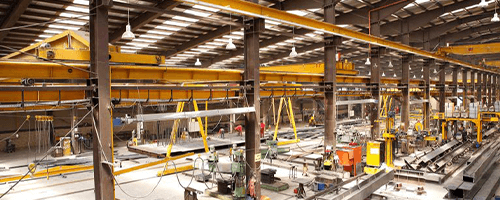
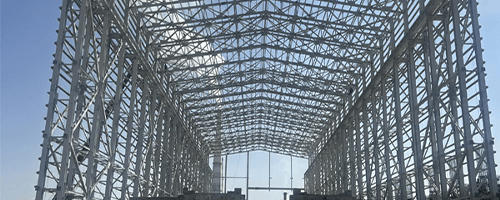
The steps of installation and construction of the metal structures
To implement metal structures and install them, you must go through the following steps:
1️⃣ The first step: implementation and execution of the columns plates
In the first step, the column plate must be installed using various methods. There are two main methods for installing the column plate.
In the first method, the base plate is connected to the columns at the factory where the steel framework is manufactured and is then connected to the building’s foundation using bolts at the project site.
In the second method, the column plate is placed directly on the foundation at the project site. Once the concrete pouring of the foundation is completed, the columns are installed onto the column plate on-site using welding.
The first method is easily implementable and is often used. For a proper installation of the steel framework using this method, a template is used during the concrete pouring of the foundation to ensure greater accuracy in the execution of the work.
2️⃣ The second step: Installation of columns
After the column plates, it’s time to install the columns. For the installation of metal columns in a steel framework structure, the column plates must be checked beforehand. Based on the weight and positioning of the columns, as well as the selection of an appropriate crane or tower crane, the installation of the columns should be carried out.
3️⃣ The third step: installing the main beams
In the next step, the main beams need to be installed. The beams are installed based on the priority established by the project team in advance, taking into account any limitations that may arise.
4️⃣ The fourth step: the final plumb line of the column
Now that the steel columns and main beams have been installed on the structure, it’s time for plumb checking. Since plumb checking plays a crucial role in transferring vertical loads and responding to seismic activity, it must be done with high precision. If the columns and walls are not plumb, the forces considered in the design may not align with reality. To address this, the steel structures code provides permissible tolerances.
5️⃣ The fifth step: installation of secondary beams
The load applied to the ceiling of a building is transmitted to the main beams through the secondary beams. The secondary beams in steel frame structures are primarily made of hot-rolled sections. Occasionally, secondary beams are also constructed using beam-plate combinations.
6️⃣ The sixth step: creating and installing the brace
Now the braces need to be installed. To connect the braces, it is first necessary to place the connection plates on the beams and columns and weld them to the side and corner sections of the beams and columns. The gusset plates must always align with the beams and columns.
Then, the braces are installed in their designated positions according to the type of connection (bolted or welded). Braces are typically made using double angle profiles and channels. After assembling the braces on the steel frame structure, it’s time for the final welding or bolting of the structure.
7️⃣ The seventh step: Connecting beams and columns by welding
At this stage, after checking and confirming all the tolerances, the final welding or tightening of the bolts and nuts is done.
8️⃣ The eighth step: final control and delivery of the structure
At this stage, all connections are inspected according to their type (welded or bolted) based on the relevant codes. If the connections fall within the permissible tolerances, they will be approved for use, allowing for the next phases of construction, such as the installation of ceilings and walls, to proceed.
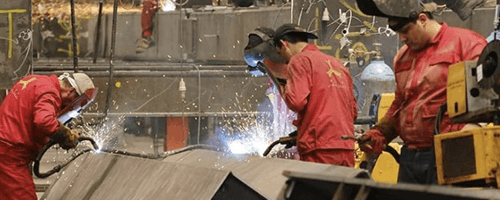
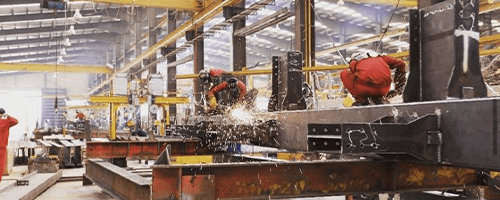
Safety Considerations in the Execution of metal Frameworks
During the construction and installation of steel frameworks, it is crucial to pay attention to important safety measures. This not only helps ensure the physical well-being of yourself and your project team but also contributes to the safety and comfort of other stakeholders (such as neighbors and pedestrians).
The most important safety guidelines for constructing and installing steel frameworks include:
- Material Handling: Use cranes and trailers to unload steel materials and beams, not manual lifting.
- Personal Protective Equipment: Wear safety clothing, gloves, and helmets to protect life.
- Welding Equipment: Use appropriate welding equipment during work.
- Skill Proficiency: Acquire high proficiency in using various machines to prevent financial and physical harm.
- Electrical Safety: Pay attention to the electrical wiring in the workshop or project site and enhance body safety when working with machines and project equipment.
- Proper Tools: Use suitable tools for transporting and lifting steel components.
- Fall Protection: Employ safety equipment to prevent falls of individuals, tools, and materials.
Execution of Metal Frameworks at the Project Site
In the past, small projects often involved the production of steel frameworks on-site. However, with the increasing importance of quality work, the necessity for regulatory tolerance control, and the lack of adequate facilities for construction on-site, this method has become outdated.
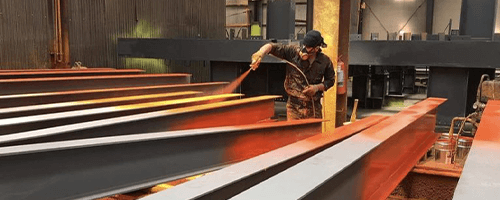
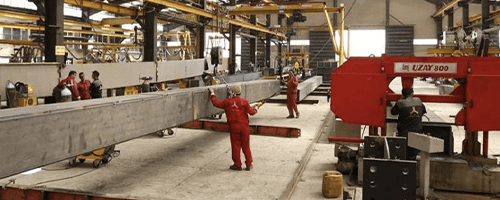
Implementation of metal framework in the factory
For industrial projects and buildings designed with steel structures, the frameworks must be produced in factories. In the construction of these structures, sections made from hot-rolled steel are typically used.
The price of implementation of metal framework in Saman Dezh Pars
One of the important questions that arises in the context of buying and selling steel frameworks is, “How much does it cost to execute such frameworks?” Generally, the cost of constructing steel frameworks is determined by various factors and criteria. The expenses related to the metal beams and sheets used in the structure, the area and number of floors of the framework, the wages of contractors, transportation costs for the project, welding costs, and more all play a significant role in this regard.
To find out the price of executing a steel framework at Saman Dezh Pars, you can coordinate with our experts in the sales department. Our sales team will conduct a thorough assessment and provide a cost estimate for the execution of your project’s steel structure as soon as they receive the plans and perform a technical inspection of the project site.
Conclusion
In this article, we introduced the process of constructing steel frameworks and highlighted the advantages of using this type of structure. Various sheets and profiles can be utilized in the construction of steel frameworks. Throughout the different stages of the project execution, a high level of precision, focus, and skill must be applied. For those of you concerned about the quality of this type of framework, by choosing Saman Dezh Pars and utilizing the services of this company, you will no longer need to worry about the quality of steel structures. For more information, please contact our experts.
Do you need specific advice?
Our engineers are ready to serve and advise you so that you have the best in any style
If you like, fill out the form below so that we can contact you as soon as possible

